Articles
- Page Path
- HOME > J Korean Powder Metall Inst > Volume 22(1); 2015 > Article
-
ARTICLE
- Simulation and Experiment of Injection Molding Process for Superalloy Feedstock
- Im Doo Jung, Youngmoo Kima, Seong Jin Park*
-
Journal of Korean Powder Metallurgy Institute 2015;22(1):1-5.
DOI: https://doi.org/10.4150/KPMI.2015.22.1.1
Published online: January 31, 2015
- *Corresponding author : Seong Jin Park, TEL: +82-54-279-2182, FAX: +82-54-279-5899, sjpark87@postech.ac.kr
• Received: January 22, 2015 • Revised: February 1, 2015 • Accepted: February 4, 2015
© Korean Powder Metallurgy Institute All rights reserved
This is an Open-Access article distributed under the terms of the Creative Commons Attribution Non-Commercial License (http://creativecommons.org/licenses/by-nc/3.0) which permits unrestricted non-commercial use, distribution, and reproduction in any medium, provided the original work is properly cited.
- 390 Views
- 3 Download
- 2 Crossref
Abstract
- Powder injection molding is an important manufacturing technology to mass produce superalloy components with complex shape. Injection molding step is particularly important for realizing a desired shape, which requires much time and efforts finding the optimum process condition. Therefore computer aided engineering can be very useful to find proper injection molding conditions. In this study, we have conducted a finite element method based simulation for the spiral mold test of superalloy feedstock and compared the results with experimental ones. Sensitivity analysis with both of simulation and experiment reveals that the melt temperature of superalloy feedstock is the most important factor for the full filling of mold cavity. The FEM based simulation matches well the experimental results. This study contributes to the optimization of superalloy powder injection molding process.
- A superalloy turbocharger has been developed to enhance the combustion efficiency of an engine by recycling heat energy of exhaust gas [1-3]. In order to improve its performance capability, the shape of the blade has been more complex [4]. Moreover, its material has been replaced by nickel-based superalloy from steel because of its excellent mechanical strength and oxidation resistance at the elevated temperature [5]. However, the superalloy obtained from casting metallurgy process exhibits degraded mechanical properties and workability due to its coarse and inhomogeneous microstructures [6]. Therefore, a new processing technique should be introduced to achieve the following conditions simultaneously; excellent hot mechanical strength, homogeneous microstructures and complex aero-dynamical shape.
- Powder injection molding (PIM) has been considered as an alternative manufacturing technique to fabricate the turbine blade because it enables production of small and precise metal components with sound microstructural properties [7]. The process is composed of several procedures; production of a feedstock, injection molding with desired shape, debinding by removing the binder ingredients, and consolidation to near full density. Among four steps, the injection molding is known to be a critical step to realize the desired shape [8]. Therefore, it is essential to optimize the injection molding process parameters, such as injection time, mold temperature, melt temperature and packing pressure. Extensive trial-and-error procedures to optimize the process conditions require excessive time and efforts, resulting in increasing production cost. Therefore, prior to the injection molding, computer simulation programs, such as Moldflow, have been applied to reduce fabrication cost [9-10]. However, there have been few researches on investigating the injection molding of superalloy feedstock for the turbocharger component.
- In this study, we have investigated the flowability of superalloy feedstock by a ladder and a spiral molds. Its experimental results were compared to the simulation ones.
Introduction
- In the present study, we used gas-atomized Inconel 713C powders (Carpenter Technology Corp.) with an average particle size of 10 mm and spherical shape as shown in the SEM image of Fig. 1. The binder system used in this study was composed of paraffin wax (PW) as a main component to control viscosity, polypropylene (PP) and polyethylene (PE) as backbone components, and stearic acid (SA) as a surface active agent. The superalloy feedstock was prepared by mixing superalloy powders and binders in a batch type mixer for 3 hours. A commercial injection molding software, Moldflow, was used to simulate the short shot series test and the sprial mold test. The rheological and thermal properties were provided from our previous works to conduct the numerical calculation. The simulation was based on the finite element method (FEM) with the governing equations, such as Hele-Shaw, Cross-WLF, and two-domain Tait PVT models. Tetrahedral elements were generated with 3D volume mesh type.
Experiment and Simulation Method
- As shown in Table 1, a short shot series test has been conducted with the ladder mold by changing charge length of injection molding machine. One can see the filling pattern of superalloy feedstock from the long cuboid side to the thin cuboid side. In No. 4, left side of cuboid was filled faster than the other end. A jetting pattern was found in No. 1 and a fully filled component was found in No. 6. In Fig. 2, these filling patterns were com- pared with simulation results. While the melt front shape of feedstock was different, the filling pattern of simulation matched well the experimental results.
- Short-shot series test
- A spiral mold was employed for the injection molding experiments and simulations. In Fig. 3, the 3D mesh model of spiral mold is shown. The feedstock was injected through sprue and gate, which are orthogonal to the spiral mold surface. There are scale marks per every centimeter on the surface of spiral mold with total length of 39 cm. When the mold is fully filled, one reads thirty nine scale marks on molded part.
- As shown in Table 2, L9 table of Taguchi method was used to conduct a sensitivity analysis for the spiral mold simulations and experiments. The injection speed, packing pressure, melt temperature, and mold temperature for each three levels are summarized in Table 3. The nine experimental spiral mold results are shown in Fig. 4. No. 1 process condition led to short-shot and No. 3, No. 5, and No. 7 led to full filling of the mold. Other conditions led to different level of filling as indicated in Fig. 4.
- The same Taguchi method with L9 table was applied to simulation and the results are shown in Fig. 5. As in experimental result of No. 1, short shot appeared in No.1 of simulation. No. 3, No. 5 and No. 9 led to full filling while other conditions led to different level of filling. For the sensitivity analysis, the larger-the-better S/N ratio analysis was used as below:
- L9 Taguchi table
- Levels for each process parameters
- where n is the number of levels for each parameters and yi is the mold filling percentage. As shown in Table 4 and Fig. 6, for the case injection speed (A), level 2 had the highest S/N ratio, which denotes that 25 mm/s could be a good injection speed condition for this spiral mold injection molding of the superalloy feedstock. For both of the packing pressure (B) and melt temperature (C), level 3 had the highest S/N ratio. Since they had higher S/N ratio in higher level, the optimum values can be at higher value than level 3. However, too high packing pressure and melt temperature are known to cause other side effect, such as flash generation or burning on the injection molded part. For mold temperature (D), level 2 led to the highest S/N ratio, which indicates that 35℃ can be an optimum mold temperature condition.
- S/N ratio analysis of experiment
- In the simulation, S/N ratios for each conditions are shown in Table 5 and Fig. 7. For the injection speed (A), level 3 led to the highest S/N ratio, which was slightly higher than level 2. While level 2 was slightly higher than level 3 in experiment, this is not a significant difference with simulation. The packing pressure (B) and melt temperature (C) had level 3 as the highest S/N ratio, which are the same with the experiment. The mold temperature (D) also showed same pattern of S/N ratio, where level 2 had the highest S/N ratio.
- S/N ratio analysis of simulation
- In Fig. 8, the influence factors of experiment and simulation are compared. For both of simulation and experiment, the melt temperature was the most influencing factor among four process condition factors. As shown in Fig. 8(b), the melt temperature effect was higher in the simulation than experiment. The packing pressure was also important influencing factor for the successful filling for both of experiment and simulation. The mold temperature and injection speed were relatively less important than other factors.
Results and Discussion
Table 1.
| Exp. No. | #1 | #2 | #3 | #4 | #5 | #6 |
|---|---|---|---|---|---|---|
| Charged length | 3 mm | 4 mm | 5 mm | 6 mm | 7 mm | 8 mm |
| Image of green parts |

|
|||||
Table 2.
| #1 | #2 | #3 | #4 | #5 | #6 | #7 | #8 | #9 | |
|---|---|---|---|---|---|---|---|---|---|
|
|
|||||||||
| A (Injection Speed) | 3 | 3 | 3 | 2 | 2 | 2 | 1 | 1 | 1 |
| B (Packing Pressure) | 1 | 2 | 3 | 1 | 2 | 3 | 1 | 2 | 3 |
| C (Melt Temperature) | 3 | 2 | 1 | 3 | 1 | 2 | 1 | 3 | 2 |
| D (Mold Temperature) | 1 | 2 | 3 | 3 | 1 | 2 | 2 | 3 | 1 |
Table 3.
| Level 1 | Level 2 | Level 3 | |
|---|---|---|---|
|
|
|||
| A (Injection Speed, mm/s) | 20 | 25 | 30 |
| B (Packing Pressure, MPa) | 117 | 147 | 177 |
| C (Melt Temperature, °C) | 150 | 160 | 170 |
| D (Mold Temperature, °C ) | 25 | 35 | 45 |
Table 4.
| A | B | C | D | ||
|---|---|---|---|---|---|
|
|
|||||
| S/N ratio | Level 1 | 61.65 | 61.65 | 50.16 | 61.97 |
| Level 2 | 88.66 | 84.35 | 90.03 | 88.88 | |
| Level 3 | 85.11 | 89.43 | 95.24 | 84.57 | |
|
|
|||||
| Influence (%) | 17.22 | 17.48 | 48.60 | 16.70 | |
Table 5.
| A | B | C | D | ||
|---|---|---|---|---|---|
|
|
|||||
| S/N ratio | Level 1 | 70.31 | 66.19 | 54.98 | 73.19 |
| Level 2 | 82.45 | 81.59 | 86.79 | 84.18 | |
| Level 3 | 83.28 | 88.25 | 94.27 | 78.67 | |
|
|
|||||
| Influence (%) | 8.16 | 19.81 | 67.35 | 4.68 | |
- Superalloy feedstock has been injection molded and simulated in a ladder mold and a spiral mold. Both of experiment and simulation showed that the melt temperature was the most important factor for full filling of superalloy feedstock in sprial mold among other process conditions as injection speed, packing pressure and mold temperature. For the packing pressure and melt temperarute, higher level had higher S/N ratio, which indicates that higher packing pressure and higher melt temperature would lead to better result. The simulation of injection molding also matched well the experimental results. This experimental and computational study can be very useful for the powder injection molding of superalloy components.
Conclusions
-
Acknowledgements
- This work was supported by the National Research Foundation of Korea (NRF) grant funded by the Korea government (NRF-2010-0026242/2011-0030075).
Acknowledgments
- 1. C Bell, Maximum Boost: Designing, Testing, and Installing Turbocharger Systems, (1997) Bentley publishers, Cambridge 31.
- 2. A Kusztelan, Y. F Wao, D. R Marchant and Y Wang: Int. J. Therm. Environ. Eng., (2011) 2 75.Article
- 3. P. R Ghodke and J G Suryawanshi: Int. J. Mech. Eng. Tech., (2012) 3 620.
- 4. B. I Mamaev and M. R Valeev: Therm. Eng., (2010) 57 786.ArticlePDF
- 5. I. A Choudhury and M. A El-Baradie: J. Mater. Process. Tech., (1998) 77 278.Article
- 6. E. A Ezugwu: J. Soc. Tribologists Lub. Engs., (1991) 47 751.
- 7. J. L Johnson, L. K Tan, P Suri and R. M German: PM2 Tec 2004 Chicago., (2004) 4 89.
- 8. C. M Wang, R. L Leonard and T. J McCabe: P/M in aerospace defense and demanding applications., (1993) San Diego 7.
- 9. L Najimi and D Lee: Int. J. Powder Metall., (1994) 30 231.
- 10. C. A Hieber and S. F Shen: J. Non-Newtonian Fluid.Mech., (1980) 7 1.Article
REFERENCES
Figure & Data
References
Citations
Citations to this article as recorded by 

- Powder Injection Molding Process in Industrial Fields
Joo Won OH, Chang Woo GAL, Daseul SHIN, Jae Man PARK, Woo Seok YANG, Seong Jin PARK
Journal of the Japan Society of Powder and Powder Metallurgy.2018; 65(9): 539. CrossRef - Effect of Diamond Particle Size on the Thermal Shock Property of High Pressure High Temperature Sintered Polycrystalline Diamond Compact
Ji-Won Kim, Min-Seok Baek, Hee-Sub Park, Jin-Hyeon Cho, Kee-Ahn Lee
Journal of Korean Powder Metallurgy Institute.2016; 23(5): 364. CrossRef
Simulation and Experiment of Injection Molding Process for Superalloy Feedstock


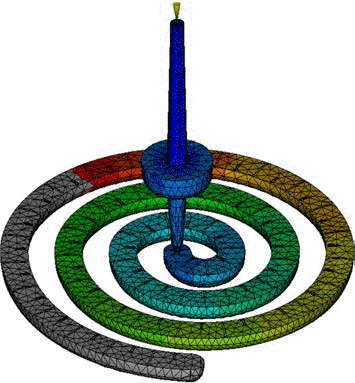

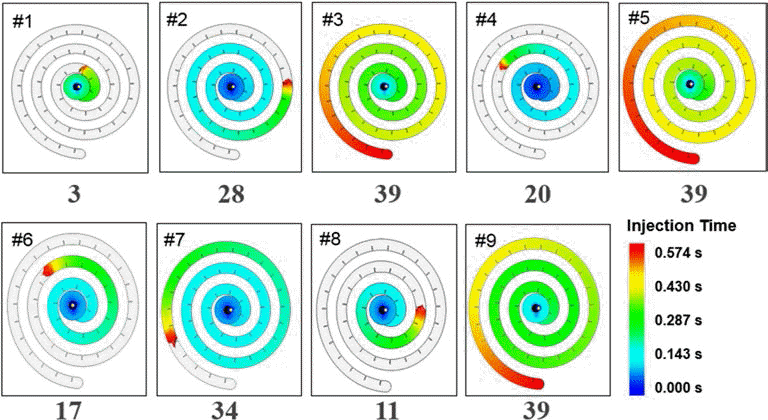
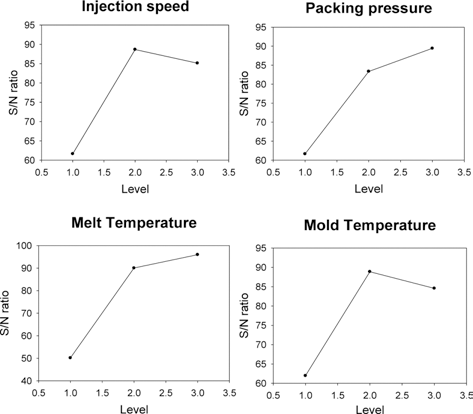

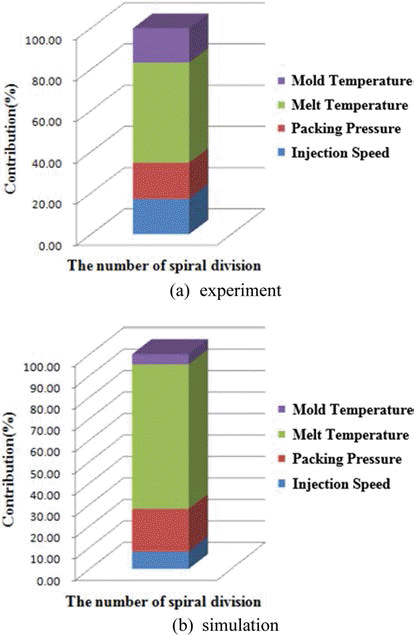
Fig. 1.
SEM image of Inconel 713C powder.
Fig. 2.
Comparison of short shot series test for experiment and simulation.
Fig. 3.
3D mesh model for spiral mold simulation.
Fig. 4.
Experimental spiral mold filling results.
Fig. 5.
Spiral mold filling simulation results.
Fig. 6.
S/N ratio of spiral mold experiment.
Fig. 7.
S/N ratio of spiral mold simulation.
Fig. 8.
Influence factor analysis for (a) experiment and (b) simulation.
Fig. 1.
Fig. 2.
Fig. 3.
Fig. 4.
Fig. 5.
Fig. 6.
Fig. 7.
Fig. 8.
Simulation and Experiment of Injection Molding Process for Superalloy Feedstock
| Exp. No. | #1 | #2 | #3 | #4 | #5 | #6 |
|---|---|---|---|---|---|---|
| Charged length | 3 mm | 4 mm | 5 mm | 6 mm | 7 mm | 8 mm |
| Image of green parts | ||||||
| #1 | #2 | #3 | #4 | #5 | #6 | #7 | #8 | #9 | |
|---|---|---|---|---|---|---|---|---|---|
|
|
|||||||||
| A (Injection Speed) | 3 | 3 | 3 | 2 | 2 | 2 | 1 | 1 | 1 |
| B (Packing Pressure) | 1 | 2 | 3 | 1 | 2 | 3 | 1 | 2 | 3 |
| C (Melt Temperature) | 3 | 2 | 1 | 3 | 1 | 2 | 1 | 3 | 2 |
| D (Mold Temperature) | 1 | 2 | 3 | 3 | 1 | 2 | 2 | 3 | 1 |
| Level 1 | Level 2 | Level 3 | |
|---|---|---|---|
|
|
|||
| A (Injection Speed, mm/s) | 20 | 25 | 30 |
| B (Packing Pressure, MPa) | 117 | 147 | 177 |
| C (Melt Temperature, °C) | 150 | 160 | 170 |
| D (Mold Temperature, °C ) | 25 | 35 | 45 |
| A | B | C | D | ||
|---|---|---|---|---|---|
|
|
|||||
| S/N ratio | Level 1 | 61.65 | 61.65 | 50.16 | 61.97 |
| Level 2 | 88.66 | 84.35 | 90.03 | 88.88 | |
| Level 3 | 85.11 | 89.43 | 95.24 | 84.57 | |
| Influence (%) | 17.22 | 17.48 | 48.60 | 16.70 | |
| A | B | C | D | ||
|---|---|---|---|---|---|
|
|
|||||
| S/N ratio | Level 1 | 70.31 | 66.19 | 54.98 | 73.19 |
| Level 2 | 82.45 | 81.59 | 86.79 | 84.18 | |
| Level 3 | 83.28 | 88.25 | 94.27 | 78.67 | |
| Influence (%) | 8.16 | 19.81 | 67.35 | 4.68 | |
Table 1.
Short-shot series test
Table 2.
L9 Taguchi table
Table 3.
Levels for each process parameters
Table 4.
S/N ratio analysis of experiment
Table 5.
S/N ratio analysis of simulation
Table 1.
Table 2.
Table 3.
Table 4.
Table 5.
TOP
 kpmi
kpmi


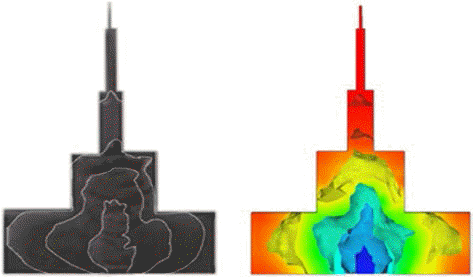

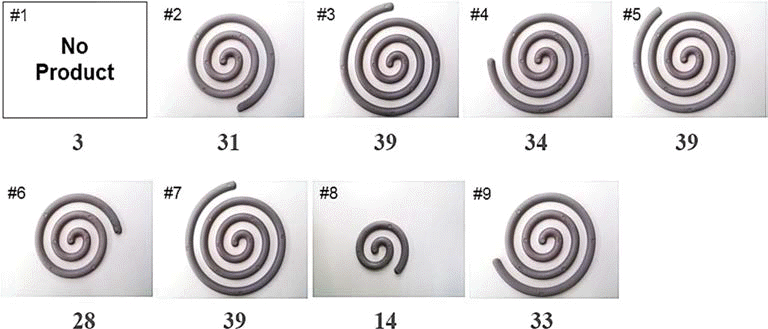


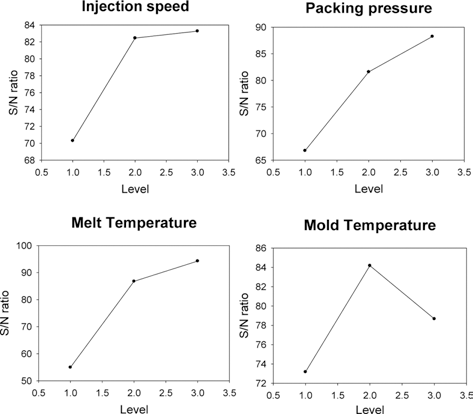

 Cite this Article
Cite this Article








